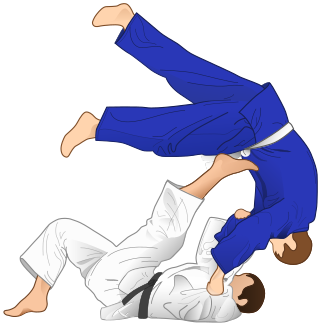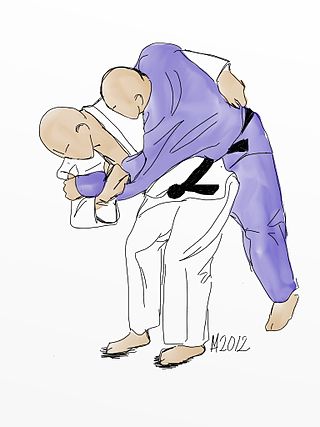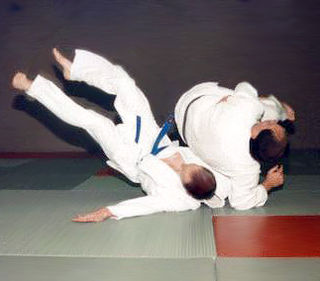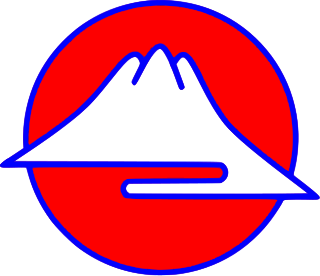
Judo is an unarmed modern Japanese martial art, Olympic sport, and the most prominent form of jacket wrestling competed internationally. Judo was created in 1882 by Kanō Jigorō as an eclectic martial art, distinguishing itself from its predecessors due to an emphasis on "randori" instead of "kata" alongside its removal of striking and weapon training elements. Judo rose to prominence for its dominance over established jujutsu schools in tournaments hosted by the Tokyo Metropolitan Police Department, resulting in its adoption as the department's primary martial art. A judo practitioner is called a "judoka", and the judo uniform is called "judogi".
In Japanese martial arts, the term atemi (当身) designates blows or strikes to the body, as opposed to twisting of joints, strangleholds, holding techniques and throws. Atemi can be delivered by any part of the body to any part of the opponent's body. They can be percussive or use "soft" power. Karate is a typical martial art focusing on percussive atemi. The location of nerve and pressure points, such as might be used for certain acupressure methods, also often informs the choice of targets for atemi.

Yoseikan budō (養正館武道) may be classified as a sōgō budō form, but is used here to indicate a martial art into which various martial ways have been integrated. It is probably most widely known for its descent from a pre-war style of aikido; however, it has important connections to judo, karate, western boxing, savate, and a traditional forms of Japanese combat known as gyokushin-ryū jujutsu and Tenshin Shōden Katori Shintō-ryū.

Nage-no-kata is one of the two randori-no-kata of Kodokan Judo. It is intended as an illustration of the various concepts of nage-waza that exist in judo, and is used both as a training method and as a demonstration of understanding.
Tenjin Shinyo-ryu, meaning "Divine True Willow School", can be classified as a traditional school (koryū) of jujutsu. It was founded by Iso Mataemon Ryūkansai Minamoto no Masatari (磯又右衛門柳関斎源正足) in the 1830s. Its syllabus comprises atemi-waza, nage-waza, torae-waza, and shime-waza. Once a very popular jujutsu system in Japan, among the famous students who studied the art were Kanō Jigorō, whose modern art of judo was greatly inspired by the Tenjin Shin'yō-ryū and Kitō-ryū.

Kuzushi is a Japanese term for unbalancing an opponent in the Japanese martial arts.

Koshiki no Kata is a kata in Judo. It is also known as Kito-ryu no Kata (起倒流の形). It consists of 21 techniques originally belonging to the Takenaka-ha Kito School of jujutsu. Jigoro Kano revised the techniques and incorporated them into a kata in order to preserve the historical source of judo. The set of forms is antique and were intended for "Kumiuchi", the grappling of armored warriors in the feudal ages. As such, the kata is to be performed with both partners imagining that they are clad in armor. The Koshiki-no-kata, together with Nage-no-kata, Katame-no-kata, Ju-no-kata, Kime-no-kata and Goshin-Jitsu, is recognised by the International Judo Federation (IJF.) Although koshiki-no-kata is not often seen in the United States, it is still taught and practiced in Japan. Some striking demonstrations of it from the 1950s can be seen in the film "Classic Judo Kata," by Harold Sharp. If the description of the kata in that film is correct, it would be the only judo kata that involves attacking the cervical spine.

Ō goshi is one of the original 40 throws of Judo as compiled by Jigoro Kano.

Tsurikomi Goshi (釣込腰), is one of the original 40 throws of Judo as developed by Jigoro Kano. It belongs to the second group, Dai Nikyo, of the traditional throwing list, Gokyo, of Kodokan Judo. It is also part of the current 67 Throws of Kodokan Judo. It is classified as a hip throwing technique, Koshi-Waza. Tsurikomi Goshi is also one of the 20 techniques in Danzan Ryu's Nage No Te list.

Soto Makikomi (外巻込) is one of the traditional forty throws of Judo as developed by Jigoro Kano. It belongs to the fourth group, Yonkyo, of the traditional throwing list, Gokyo, of Kodokan Judo. It is also part of the current 67 Throws of Kodokan Judo. Because tori takes a side fall next to uke, the technique is categorized as a side sacrifice technique, Yoku-sutemi. Danzan Ryu's Makikomi (巻込) is also one of the twenty throws in the Nagete list, which most closely resembles Soto Makikomi.

Uki otoshi (浮落), or "floating drop," is one of the traditional forty throws of Judo as developed by Jigoro Kano. It belongs to the fourth group, Dai Yonkyo, of the traditional throwing list, Gokyo-no-Nagewaza, of Kodokan Judo. It is also part of the current 67 Throws of Kodokan Judo. The technique is categorized as a hand technique, Te-waza.

Utsuri Goshi (移腰), or the changing hip throw, is one of the original 40 throws of Judo as developed by Jigoro Kano. It belongs to the fourth group, Yonkyo, of the traditional throwing list, Gokyo-no-Nagewaza, of Kodokan Judo. It is also part of the current 67 Throws of Kodokan Judo. It is classified as a hip technique, Koshi-Waza.

The Canon of Judo is a book that was originally published in 1956, and written by Kodokan 10th dan, Kyuzo Mifune (1883-1965). The book covers almost all of the Kodokan recognized techniques, adds variations and new techniques, including Do-Jime in passing as well. The book also describes fifteen Kata developed by Mifune to teach adaptation through reversal and counters. The book organizes the techniques differently from the official Kodokan Gokyo.

Jigoro Kano was a Japanese educator, athlete, and the founder of Judo. Along with Ju-Jutsu, Judo was one of the first Japanese martial arts to gain widespread international recognition, and the first to become an official Olympic sport. Pedagogical innovations attributed to Kanō include the use of black and white belts, and the introduction of dan ranking to show the relative ranking among members of a martial art style. Well-known mottoes attributed to Kanō include "good use of energy" and "mutual welfare and benefit".

Yoseikan Aikido is the aikido taught at the Yoseikan Dojo in Shizuoka, Japan, under the direction of Minoru Mochizuki.

Kyūshin-ryū is a form of the martial art Jujutsu consisting of striking, throwing and grappling techniques. It was developed by the Samurai in feudal Japan as a method of dispatching an armored opponent using unarmed techniques. According to the Densho of various schools and historical records, these systems of unarmed combat began to be known as Jujutsu during the Muromachi period (1333–1568).

Jujutsu, also known as jiu-jitsu and ju-jitsu, is a family of Japanese martial arts and a system of close combat that can be used in a defensive or offensive manner to kill or subdue one or more weaponless or armed and armored opponents. Jiu-jitsu dates back to the 1530s and was coined by Hisamori Tenenouchi when he officially established the first jiu-jitsu school in Japan. This form of martial arts uses few or no weapons at all and includes strikes, throws, holds, and paralyzing attacks against the enemy. Jujutsu developed from the warrior class around the 17th century in Japan. It was designed to supplement the swordsmanship of a warrior during combat. A subset of techniques from certain styles of jujutsu were used to develop many modern martial arts and combat sports, such as judo, aikido, sambo, ARB, Brazilian jiu-jitsu, and mixed martial arts. The official date of foundation of Jiu Jitsu is 1530.
Atemi Ju-Jitsu, in Japanese: Atemi (当て身) Jujutsu (柔術), also called Pariset Ju-Jitsu, was established in France in the 1940s by the late Judo and Ju-Jitsu legend Bernard Pariset to revive and preserve old martial techniques inherited from Feudal Japan.
Fusen-ryū is a traditional school of jujutsu founded by Motsugai Takeda. It contains an extensive system of martial arts, including unarmed fighting (jujutsu), staff (bōjutsu), short staff (jojutsu), sword (kenjutsu), sword drawing (iaijutsu), glaive (naginatajutsu), scythe (nagikamajutsu), scythe and chain (kusarigamajutsu), and jitte (jittejutsu).

Matsugoro Okuda was a Japanese martial artist. A master of several jujutsu styles, he was a contemporary to Jigoro Kano in the creation of a style that synthesized them all, and opposed the early judo movement before later joining it.















